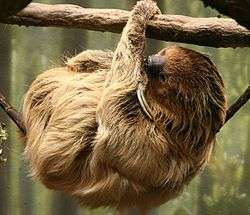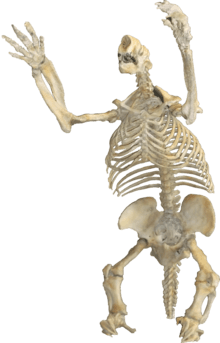Megalonychidae
| Megalonychidae | |
|---|---|
 | |
| Choloepus didactylus | |
| Scientific classification | |
| Kingdom: | Animalia |
| Phylum: | Chordata |
| Class: | Mammalia |
| Superorder: | Xenarthra |
| Order: | Pilosa |
| Family: | Megalonychidae Gervais 1855 |
| Subfamilies | |
|
See text | |
Megalonychidae is a group of sloths including the extinct Megalonyx and the living two toed sloths. Megalonychids first appeared in the early Oligocene, about 35 million years ago, in southern Argentina (Patagonia), and spread as far as the Antilles by the early Miocene.[1] Megalonychids first reached North America by island-hopping, about 9 million years ago, prior to the formation of the Isthmus of Panama. Some megalonychid lineages increased in size as time passed. The first species of these were small and may have been partly tree-dwelling, whereas the Pliocene (about 5 to 2 million years ago) species were already approximately half the size of the huge Late Pleistocene Megalonyx jeffersonii from the last ice age. Some West Indian island species were as small as a large cat; their dwarf condition typified both tropical adaptation and their restricted island environment. This small size also enabled them a degree of arboreality.[2]
Megalonychid ground sloths became extinct in North and South America around the end of the Pleistocene, and in the Antilles apparently by about 5000 BP,[3] leaving two-toed tree sloths of genus Choloepus as the only surviving members of the family.
Evolution

Megalonyx, which means "giant claw", is a widespread North American genus that lived past the close of the last (Wisconsin) glaciation, when so many large mammals died out. Remains have been found as far north as Alaska and the Yukon.[4][5] Ongoing excavations at Tarkio Valley in southwest Iowa may reveal something of the familial life of Megalonyx. An adult was found in direct association with two juveniles of different ages, suggesting that adults cared for young of different generations.[6][7]
The earliest known North American megalonychid, Pliometanastes protistus, lived in Florida and the southern U.S. about 9 million years ago, and is believed to have been the predecessor of Megalonyx. Several species of Megalonyx have been named; in fact, a 2000 article by Harington et al in Arctic claimed that "nearly every good specimen has been described as a different species".[4] A broader perspective on the group, accounting for age, sex, individual and geographic differences, indicates that only three species are valid (M. leptostomus, M. wheatleyi, and M. jeffersonii) in the late Pliocene and Pleistocene of North America.[8] Although work by McDonald lists five species.
Jefferson's ground sloth has a special place in modern paleontology, for Thomas Jefferson's letter on Megalonyx, read before the American Philosophical Society of Philadelphia, in August 1796, marked the beginning of vertebrate paleontology in North America.[4] When Lewis and Clark set out, Jefferson instructed Meriwether Lewis to keep an eye out for ground sloths. He was hoping they would find some living in the Western range. Megalonyx jeffersonii was appropriately named after Thomas Jefferson.[4]
Taxonomy
Family Megalonychidae Gervais 1855
|
|
References
| Wikispecies has information related to Megalonychidae |
- ↑ Morgan, Gary S. (2002). "Late Rancholabrean Mammals from Southernmost Florida, and the Neotropical Influence in Florida Pleistocene Faunas". In Emry, Robert J. Cenozoic Mammals of Land and Sea: Tributes to the Career of Clayton E. Ray. Smithsonian Contributions to Paleobiology. 93. Washington, D.C.: Smithsonian Institution Press. pp. 15–38.
- ↑ J.L. White (1993)
- ↑ Steadman, D. W.; Martin, P. S.; MacPhee, R. D. E.; Jull, A. J. T.; McDonald, H. G.; Woods, C. A.; Iturralde-Vinent, M.; Hodgins, G. W. L. (2005-08-16). "Asynchronous extinction of late Quaternary sloths on continents and islands". Proc. Natl. Acad. Sci. USA. National Academy of Sciences. 102 (33): 11763–11768. doi:10.1073/pnas.0502777102. PMC 1187974. PMID 16085711. Retrieved 2009-01-24.
- 1 2 3 4 Harrington (1993)
- ↑ McDonald, H. G.; Harington, C. R.; De Iuliis, G. (September 2000). "The Ground Sloth Megalonyx from Pleistocene Deposits of the Old Crow Basin, Yukon, Canada" (PDF). Arctic. Calgary, Alberta: The Arctic Institute of North America. 53 (3): 213–220. doi:10.14430/arctic852. Retrieved 2008-08-16.
- ↑ Semken and Brenzel, "Archived copy". Archived from the original on 2009-01-01. Retrieved 2009-09-25.
- ↑ Semken; Brenzel (2007). "One Sloth Becomes Three". Newsletter of the Iowa Archeological Society. 57: 1.
- ↑ Kurtén & Anderson, 1980, p. 136.
Further reading
- Brandoni, Diego. 2014. A new genus of Megalonychidae (Mammalia, Xenarthra) from the Late Miocene of Argentina. Revista Brasileira de Paleontologia 17. 33–42. Accessed 2018-10-08.
- Brandoni, Diego. 2011. The Megalonychidae (Xenarthra, Tardigrada) from the late Miocene of Entre Ríos Province, Argentina, with remarks on their systematics and biogeography. Geobios 44. 33–44. Accessed 2018-10-08.
- Brandoni, Diego. 2008. Nuevos materiales de Ortotheriinae (Xenarthra, Tardigrada, Megalonychidae) procedentes del "Mesopotamiense" (Mioceno tardío) de Entre Ríos. Temas de la Biodiversidad del Litoral 17. 11–20. Accessed 2018-10-08.